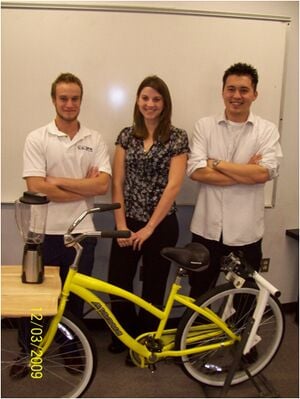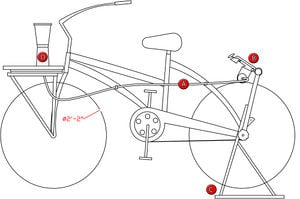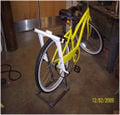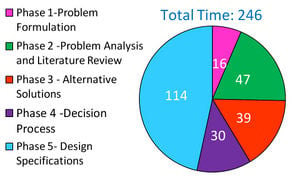O Programa de Engenharia de Recursos Ambientais da Cal Poly Humboldt teve a oportunidade de criar um liquidificador movido a bicicleta para a Região Litoral Norte da Rede para uma Califórnia Saudável. A Equipe Evergreen se reuniu com Michelle Postman, representante da Rede, para discutir e supervisionar o projeto. A Equipe Evergreen consiste em três membros inscritos no Engineering 215: Carlos Carma, Jessica Bruce , e Brian Wallace .
Conteúdo
Fundo
Engenharia 215 é uma aula que se concentra em dinâmica de grupo, gerenciamento de tempo, satisfação do cliente e projetos de engenharia complexos. A aula oferece treinamento em Auto CAD, Excel, Word, Powerpoint e exige que os alunos aprendam a usar um programa de design gráfico por conta própria. 50% da nota em Engenharia 215 é um projeto de design em grupo. Esta página é dedicada ao projeto da Team Evergreen, denominado Smooth Ridin'. A turma tem 12 semanas para concluir um documento de design de sessenta páginas que implementa as cinco etapas do projeto de engenharia.
O processo de design é o seguinte:
- Defina o problema.
- Pesquise soluções anteriores e aspectos do problema.
- Fornecer soluções alternativas para o problema
- Escolha uma solução
- Projetar e implementar a solução
Declaração e critérios do problema
O objetivo da Team Evergreen é projetar um liquidificador movido a energia humana que seja portátil, prático e eficiente. A Rede para uma Califórnia Saudável (Região Litoral Norte) planeja ensinar como praticar um estilo de vida saudável por meio de atividades físicas.
O liquidificador movido a bicicleta deve atender aos seguintes critérios:
- A bicicleta deve caber no porta-bicicletas do carro.
- O sistema deve ser fácil de mover em um estacionamento.
- O liquidificador deve estar na frente do operador e ser fácil de ver.
- A mesa deve ser o mais leve possível.
- A bicicleta deve suportar ciclistas com idade igual ou superior a oito anos e pessoas com até 300 libras.
- O assento deve ser ajustável.
- O aparelho deve ter uma aparência profissional.
- O liquidificador de bicicleta deve durar até cinco anos com uso mensal.
- O design e a produção do projeto não devem exceder US$ 325.
Descrição do Projeto Final
O projeto final deverá incluir:
- Bicicleta Cruiser
- Treinador de bicicleta
- Liquidificador Vórtice
- Eixo flexível de 56"
- Mesa de corte
- Assento ajustável
- Laços zip
- Parafusos, porcas e pernos
- Sucata de aço
- Encaixe personalizado para fixação de eixo flexível no treinador
- Eixo interno personalizado dentro do liquidificador Vortex
The apparatus is made from a yellow cruising bicycle that has a bicycle stand connected to the rear axle to elevate the rear tire keeping the bicycle stationary. The challenge of the design process was choosing how to get the blades to spin by pedaling and rotating the tire. A 63" Fordom flex shaft was chosen because of its ability to bend rotational energy. A flex shaft is a device that transfers rotary motion over a limited distance and bends to a desired shape. The flex shaft is represented by (A) in Figure 1. Using the back tire to provide the rotational energy minimizes the amount of alteration to the original bicycle. The flex shaft runs from the trainer apparatus to the bottom of the blender, where it is attached by a screw inside the base of the blender. The screw can be turned by one half turn of an allen wrench to remove the flex shaft from the bottom of the blender. The flex shaft is attached to the bicycle with yellow zip ties that match the color of the bicycle and keep the flex shaft away from the pedals. A bicycle trainer is a stand that holds the bicycle's back tire elevated in the air and providing resistance for indoor exercise by pressing a wheel against the tire. The trainer needed to be modified because the flex shaft cannot reach the blender when the trainer is on the ground. The rotating mechanism attached to the trainer's wheel in Figure 1 represented by (B) was used to attach the flex shaft. The original rotating mechanism has an axle that was attached to a large red disk, which was removed. In place of the red disk a threaded custom fitting was attached for easy setup to the flex shaft. The flex shaft is twisted counterclockwise to fit the custom fitting. The flex shaft must be aligned with the axle before it can be attached.Half of the bicycle trainer was adapted to the apparatus, which was attached to two steel frames that support the bicycle. The trainer is positioned above the tire to minimize the distance between the tire and the blender represented in Figure 1 (B). A steel stand was welded as shown as C in Figure 1, and bolted onto the original trainer's frame. The trainer wheel that presses against the tire, (shown as B in Figure 1) can be adjusted up and down by rotating a screw with a large black handle. It can also be adjusted by pushing down on the spring-loaded device labeled (B) up and down.The blender used above the table is a Vortex Hand Crank Blender, which is made up of two main parts; the blender and the base. The base (shown in Figure 1 as D) originally contained gears, but they were removed to make room for a custom axle. This custom axle transfers the rotational energy from the flex shaft to the top of the base where the blender is attached and is one of the strongest parts of Smooth' Ridin, because it is made of a strong metal and is protected inside of the base.
Photos and Video
Costs
A equipe Evergreen conseguiu economizar dinheiro por meio de doações e da descoberta de peças usadas em fóruns como craigslist.org. Os custos de varejo das peças são contrastados com o que a Team Evergreen teve que pagar na tabela abaixo.
| Papel | Custo de varejo | Preço pago |
| Eixo Flexível Fordom 63" | US$ 63,00 | US$ 63,00 |
| Liquidificador de manivela Vortex | US$ 29,99 | doado |
| Bicicletário | US$ 16,99 | US$ 10 |
| Treinador da equipe Magturbo III | US$ 270,00 | US$ 40,00 |
| Bicicleta Cruzadora | US$ 108,49 | US$ 108,49 |
| Tábua de cortar | US$ 7,99 | US$ 7,99 |
| Suportes de aço | US$ 7,30 | doado |
| Acessórios personalizados | US$ 10 | doado |
| Liberação rápida do assento da bicicleta | US$ 4,99 | doado |
| Total | US$ 518,76 | US$ 259,47 |
O Vortex Blender, os acessórios personalizados e os suportes de aço para o treinador foram doados por Marty Reed (especialista em mecânica) da Cal Poly Humboldt. O Bike Seat Quick Release foi doado pela Life Cycle Bike Shop (localizada em Arcata em G).
A equipe Evergreen dedicou muito tempo ao design e documentação de seu projeto, mostrado abaixo em um diagrama (os números representam horas):
Discussão e Próximos Passos
A Team Evergreen forneceu à Network for a Healthy California – Northcoast Region um produto que atende às metas estabelecidas pelos critérios do cliente. O liquidificador para bicicletas é leve o suficiente para ser colocado em um bicicletário e pode ser facilmente transportado devido ao sistema de duas partes. A bicicleta selecionada foi uma bicicleta cruiser, que é mais pesada que outros modelos, portanto, se este projeto fosse feito novamente, uma bicicleta com quadro mais leve seria uma solução melhor.
Obrigado
Marty Reed - Técnico de Equipamentos
Lonny Grafman - Supervisor de Projeto
Bart Orlando - Consultor de Projetos
Michelle Postman - Cliente e Representante de uma Rede para uma Califórnia Saudável (Região Litoral Norte)







